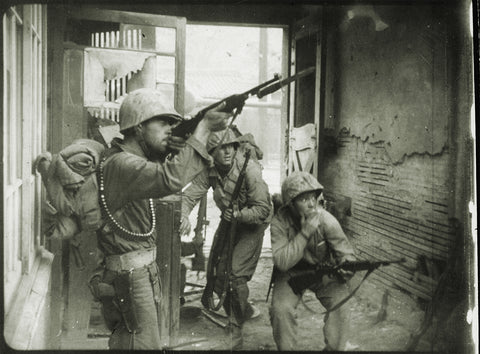
The Korean War Is Far From Over
No, technically, it’s not over, though overt hostilities stopped 70 years ago.
On June 25, 1950, the Democratic People’s Republic of Korea (DPRK, or North Korea) invaded the Republic of Korea (ROK, or South Korea), sparking the first hot conflict of the Cold War—a proxy war between China and the Soviet Union in support of the north, and the United States and its United Nations allies in the south. Crossing the 38th parallel, the DPRK’s Korean People’s Army (KPA) pushed ROK and U.S. forces south, trapping them behind the 140-mile Pusan Perimeter. In response, the U.N. sent troops, 21 nations ultimately contributing to the effort.
Assuming command of U.N. forces, General Douglas MacArthur turned the tide with Operation Chromite, the amphibious landing of troops at Inchon, southwest of Seoul. Reinforced U.N. forces also broke out of the Pusan Perimeter, pushing the KPA back across the 38th parallel. Coalition forces then invaded North Korea, aiming to reunify the Korean Peninsula, with leading elements reaching the Yalu River border with China.
At that imminent threat, Chinese troops poured into North Korea and launched a series of offensives against ROK and U.N. forces. The fighting was fierce as combatant forces seesawed back and forth. Notable battles included those on the Chosin Reservoir and the Chongchon River. Eventually, the front lines stabilized along the 38th parallel and a long stalemate ensued, though where fighting broke out, such as the three Battles of the Hook, it proved especially bitter.
this article first appeared in Military History magazine
Peace talks began in July 1951, but disagreement over the repatriation of POWs led to protracted negotiations. The conflict dragged on, claiming the lives of as many as 5 million civilians and military personnel, until the signing of the Korean Armistice Agreement at Panmunjom on July 27, 1953. Tensions remain.
In the mid to late 1960s a series of incidents threatened the armistice, including armed clashes along the DMZ separating north and south, the attempted assassination of South Korean President Park Chung Hee (amid the January 1968 Blue House Raid), the capture of the U.S. spy ship Pueblo that same month and North Korea’s 1969 shootdown of a U.S. Lockheed EC-121M Warning Star spy plane over the Sea of Japan, killing 31 crewmen.
North Korea has become increasingly isolated on the world stage, particularly in the wake of the Cold War. In 1994 President Bill Clinton, on receiving intel that North Korea was developing nuclear weapons, weighed bombing its nuclear reactor at Nyongbyon. In 2002, in the wake of the Sept. 11, 2001, terrorist attacks, President George W. Bush included North Korea in his “axis of evil” list of states sponsoring terrorism. In June 2019 Donald Trump tried a different tack, becoming the first sitting U.S. president to set foot in North Korea when he stepped into the DMZ to shake hands with North Korean Supreme Leader Kim Jong Un. Despite such overtures, Kim has recently stepped up the rhetoric and since resumed the missile tests.
Lessons
Beware short-term commitments: The United States occupied South Korea at war’s end in 1945 and withdrew three years later, leaving South Korea weak and ill prepared to resist a North Korean invasion, once again necessitating military intervention.
Ignore intelligence at your own peril: In October 1950 MacArthur dismissed
information regarding Chinese troop movements and assured Washington that
Beijing would not intervene.
Chinese troops crossed the Yalu on the 19th and attacked on the 25th.
Sometimes divorce is inevitable: Today South Korea is a thriving, modern republic, while North Korea remains a communist backwater. Reconciliation seems unlikely.
This story appeared in the Winter 2024 issue of Military History magazine.
historynet magazines
Our 9 best-selling history titles feature in-depth storytelling and iconic imagery to engage and inform on the people, the wars, and the events that shaped America and the world.
